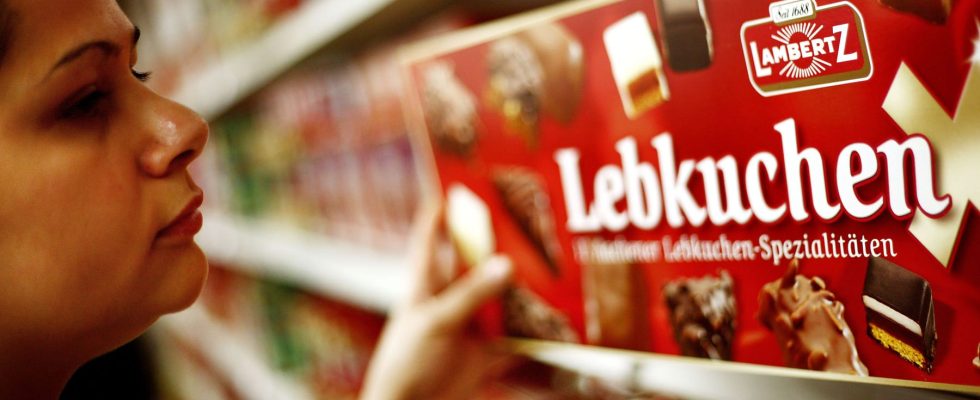Sugar has become up to 100 percent more expensive this year. This is also reflected in the price of Christmas sweets. Only one thing retains the price tag from last year.
The clock is ticking: Christmas Eve is three months away – and many Christmas sweets such as gingerbread, dominoes and speculoos are already available in the supermarket. What is striking is that inflation does not stop before Christmas. Many products have become more expensive. t-online does the check: How much do Christmas sweets cost compared to last year? How much will we have to spend on a Christmas tree? And who can still afford a Christmas goose this year?
Christmas sweets
Confectionery manufacturers have particularly raised prices. One reason: the higher producer prices in electricity-intensive production. Gingerbread cookies are baked in ovens, chocolate is melted and then poured into the shape of a Santa Claus. The Printenfabrik Lambertz in Aachen, for example, has 28 ovens – all powered by gas.
“The enormous cost burden is increasingly becoming a location decision or even a question of existence for companies in the German confectionery industry,” says Solveig Schneider, spokeswoman for the Federal Association of the German Confectionery Industry, to t-online.
The procurement of raw materials is also becoming increasingly difficult for food producers, complains Schneider. Sugar in particular is driving up the price of confectionery: you pay 87.2 percent more for the sweet raw material compared to 2022, as the Federal Statistical Office recently announced. In response to a t-online request, Lambertz even said: Some types of sugar are more than 100 percent more expensive than last year.
“Companies can no longer adequately cover their needs for sugar as a raw material for a longer period of time,” says association spokeswoman Schneider. This makes it difficult, especially for small and medium-sized companies, to plan and set prices. According to the Federal Association of the German Confectionery Industry, the costs of cocoa (+25 percent), corn (+19 percent) and wheat (+12 percent) have also risen sharply.
At Lambertz, they justify the higher prices for gingerbread with another argument. “We start producing Christmas cookies in June, and the necessary raw materials are ordered over the longer term – partly via commodity futures exchanges,” Lambertz spokesman Martin Heinen tells t-online. At that time, raw material prices were sometimes even higher.
Households are also feeling this: At the moment, food is the main driver of inflation. The t-online shopping cart proves this. Food currently costs 7.6 percent more than last year. In the first half of the year, prices for sweet pastries and cakes rose by 22.3 percent compared to the same period last year, as measured by the market research institute Circana.
t-online has compared current prices for Christmas sweets. Here is a selection:
- dominoes currently cost 2.11 euros at Lidl. Last year you only paid 1.99 euros. That is a Plus of 6 percent.
- Elisen Gingerbread from Printenfabrik Lambertz from Aachen currently costs 6.95 euros in the online shop. Last year you only paid 5.95 euros. That corresponds to one Plus of 16 percent.
- Mozartkugeln from Chateau currently costs 2.69 euros at Aldi Nord. Last year you paid 2.19 euros. That is a Plus of 23 percent.
- Spice speculoos currently cost 1.59 euros at Lidl. Last year you only paid 1.19 euros. A Plus of 33 percent.
Christmas goose
Anyone who doesn’t want to celebrate Christmas without a goose knows: the fine meat is expensive, especially if it comes from local production. You have to pay 20 euros for a kilo of goose meat from German farming, says Wolfgang Schleicher, managing director of the Central Association of the German Poultry Industry, in an interview with t-online.
This means the price is roughly the same as last year. “Last year the price increases were due to the increase in the price of feed and higher energy costs,” says Schleicher. There should be no further price increase for Christmas goose this year.
However, you have to know: “Only ten percent of the geese eaten in Germany come from Germany. Many geese from other EU countries come from foie gras production.” According to the Federal Statistical Office, 2,380 tons of geese were slaughtered in Germany last year – the number has been declining for years.
Such geese, often from Poland, where foie gras production is not banned, cost significantly less. Last year, a goose from another EU country was sold for around 6 euros per kilo, according to the head of the association. “Under these conditions, German goose breeders cannot keep up in terms of price.” Geese from foie gras production do not have to be labeled in Germany. “We demand this from politicians,” says Schleicher.

